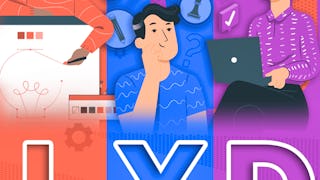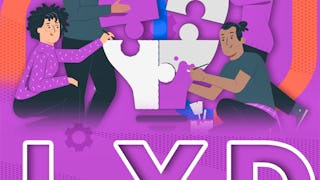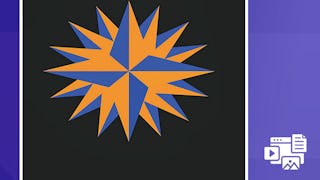In Theories and Frameworks, you’ll take a close look at learners and learning contexts. As you define your target audience, you’ll learn how to use learner personas as a communication tool with stakeholders and how these can be used to influence learning goals, assessments, and activities.

Enjoy unlimited growth with a year of Coursera Plus for $199 (regularly $399). Save now.

Learning Experience Design: Theories and Frameworks
This course is part of An Introduction to Learning Experience Design (LXD) Specialization


Instructors: Rebecca Quintana, PhD
3,809 already enrolled
Included with
(36 reviews)
What you'll learn
Analyze learner needs and learning contexts
Implement taxonomies and theories for design
Align learning outcomes with course outlines
Skills you'll gain
Details to know

Add to your LinkedIn profile
See how employees at top companies are mastering in-demand skills

Build your subject-matter expertise
- Learn new concepts from industry experts
- Gain a foundational understanding of a subject or tool
- Develop job-relevant skills with hands-on projects
- Earn a shareable career certificate

There are 4 modules in this course
In Week 1 of the course, you’ll focus on developing a vision of the learner and of the learning context. You’ll revisit ideas from learner-centered design and the “designing for all learners” mindset we discussed in course one. Using a design process frame, you’ll consider the kinds of information you need to gather about your learner audience and context and identify approaches for analyzing this information. Finally, you’ll explore the role of learner personas in aiding decision making with project stakeholders.
What's included
5 videos10 readings2 assignments1 app item3 discussion prompts
In Week 2 of the course, you’ll focus on different theories and perspectives on learning, and consider ways that these theoretical ideas can inform learning experience design. You will review ideas from overviews of three major learning theories: Behaviorism, Cognitivism, and Constructivism. You will note how different learning theories lead to different ideas about what constitutes learning, and what kind of activities can support learning. You will also look at some perspectives and theories about motivation. You will review ideas about extrinsic and intrinsic motivation, and review Self-Determination Theory to identify different dimensions that can motivate people. All of these ideas can help you see how you might design learning experiences in ways that can motivate learners.
What's included
6 videos7 readings3 assignments2 app items2 discussion prompts
In Week 3 of the course, you will look at different learning taxonomies (i.e., Bloom’s Taxonomy, Fink’s Taxonomy) that serve as ways of describing knowledge so that we can design learning experiences that include activities for learners that will help them gain that knowledge. You will also look at learning outcomes and see the characteristics of good learning outcomes to help you develop the outcomes that will be the foundation for a learning experience. Finally, you will look at learning design frameworks, which describe specific conceptual approaches that help you as you are shaping a learning experience. These three concepts–learning taxonomies, learning outcomes, and learning design frameworks–-are all related, and you will see the interplay between these to help you describe and develop learning outcomes and learning activities for your designs.
What's included
6 videos8 readings3 assignments1 app item3 discussion prompts
This week, you will explore the initial phases of the design process that involve brainstorming activities and developing the initial ideas for a new design. You will begin by looking at tools for these ideation and brainstorming activities. We will discuss conceptual tools and how they help articulate and concretize ideas, especially for ideation and brainstorming, and then later for outlining the learning experience you are designing. You will connect to our earlier discussions about the iterative nature of design to see how these tools support design by helping you describe your ideas in order to communicate them to the team and stakeholders, get feedback, and use this to refine and generate new ideas. You will then have a chance to reflect on how these types of activities and tools fit with the LXD core competencies as you think about how you can build these types of skills.
What's included
3 videos13 readings1 assignment1 peer review2 app items3 discussion prompts
Earn a career certificate
Add this credential to your LinkedIn profile, resume, or CV. Share it on social media and in your performance review.
Offered by
Explore more from Education
 Status: Free Trial
Status: Free TrialUniversity of Michigan
 Status: Free Trial
Status: Free TrialUniversity of Michigan
 Status: Free Trial
Status: Free TrialUniversity of Michigan
Why people choose Coursera for their career




Learner reviews
36 reviews
- 5 stars
91.66%
- 4 stars
5.55%
- 3 stars
2.77%
- 2 stars
0%
- 1 star
0%
Showing 3 of 36
Reviewed on Dec 13, 2025
Clear information, easy to navigate. Great instructors
Reviewed on Mar 24, 2025
General overview with lots of future reading recommendations
Frequently asked questions
To access the course materials, assignments and to earn a Certificate, you will need to purchase the Certificate experience when you enroll in a course. You can try a Free Trial instead, or apply for Financial Aid. The course may offer 'Full Course, No Certificate' instead. This option lets you see all course materials, submit required assessments, and get a final grade. This also means that you will not be able to purchase a Certificate experience.
When you enroll in the course, you get access to all of the courses in the Specialization, and you earn a certificate when you complete the work. Your electronic Certificate will be added to your Accomplishments page - from there, you can print your Certificate or add it to your LinkedIn profile.
Yes. In select learning programs, you can apply for financial aid or a scholarship if you can’t afford the enrollment fee. If fin aid or scholarship is available for your learning program selection, you’ll find a link to apply on the description page.
More questions
Financial aid available,
¹ Some assignments in this course are AI-graded. For these assignments, your data will be used in accordance with Coursera's Privacy Notice.






